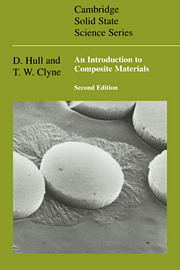Book contents
- Frontmatter
- Contents
- From the preface to First Edition
- Preface to Second Edition
- 1 General introduction
- 2 Fibres and matrices
- 3 Fibre architecture
- 4 Elastic deformation of long-fibre composites
- 5 Elastic deformation of laminates
- 6 Stresses and strains in short-fibre composites
- 7 The interface region
- 8 Strength of composites
- 9 Toughness of composites
- 10 Thermal behaviour of composites
- 11 Fabrication
- 12 Applications
- Appendix: Nomenclature
- Author index
- Subject index
12 - Applications
Published online by Cambridge University Press: 05 June 2012
- Frontmatter
- Contents
- From the preface to First Edition
- Preface to Second Edition
- 1 General introduction
- 2 Fibres and matrices
- 3 Fibre architecture
- 4 Elastic deformation of long-fibre composites
- 5 Elastic deformation of laminates
- 6 Stresses and strains in short-fibre composites
- 7 The interface region
- 8 Strength of composites
- 9 Toughness of composites
- 10 Thermal behaviour of composites
- 11 Fabrication
- 12 Applications
- Appendix: Nomenclature
- Author index
- Subject index
Summary
Composite materials are used in a very wide range of industrial applications. In this chapter, the objective is to identify some of the considerations involved in commercial exploitation of composites. This is done by means of a few case studies and there is no attempt to present a systematic survey. The examples given cover a range of composite type, engineering complexity, manufacturing route, market size and competitive position relative to conventional materials. At the beginning of each case study, a list is given identifying the reasons for preferring a composite to more conventional engineering materials. Although the examples are spread over the full range of matrix types, the bulk of the annual composite production of around 10 million tonnes is currently in the form of PMCs. At the start of each example, a list is given of the requirements of the application.
Minesweeper hull
low density
ease of moulding to complex shape
non-magnetic
good resistance to corrosion and marine fouling
good resistance to fatigue and stress corrosion cracking
Glass-reinforced plastic (GRP) is now very popular for various land and sea transport applications. While large ships are usually constructed in steel, over 80% of marine hulls less than about 40 m in length are made of GRP (Smith 1990). This is partly because fabrication in GRP is more economic for relatively small craft.
- Type
- Chapter
- Information
- An Introduction to Composite Materials , pp. 295 - 310Publisher: Cambridge University PressPrint publication year: 1996
- 1
- Cited by



